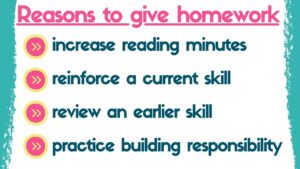
Research on Homework Benefits
To give homework or not? This has been a long-standing debate for educators everywhere. You can find research on homework benefits and about how homework can be detrimental to your students. Most educators can see both sides of the argument. That’s because when it comes down to it – both sides are correct!
In this article, I’ll outline what I gathered from my own research and how I implement homework in a positive & beneficial way. Stick with me because there’s a ✨✨FREE DOWNLOAD✨✨ at the end of this article!
Let’s take a look at what the research says are the pros and cons of homework.
Cons of homework:
- Homework that’s too difficult or time consuming, can cause unnecessary stress on students. This can lead to a poor attitude about both school and learning at home.
- Homework can be inequitable for students without support at home.
- Many kids have limited “free time” outside of school due to structured activities such as sports and clubs. Kids need time to be kids!
- Homework can create a nightly struggle and have a negative effect on the parent/child relationship. This can be especially true when the demands of the homework are too high.
Pros of homework:
- Students develop study skills, such as time management and organizational skills, from an early age. This can benefit them when they get older and studying at home is necessary.
- Kids learn to be disciplined with their decision making and responsibility. Homework gives kids a chance to try-out their decision making. They build their “responsibility muscles” by weighing out what they want to do vs what they should do!
- As adults, we show kids what we value by what we put our time into. Often, kids’ time outside of school is spent in structured activities and leisurely on technology. When we invest time in academics, it shows our kids that we value learning.
- There are many benefits (academically, socially, emotionally and physically) for kids who read daily. You can read more about these benefits in this blog post.
I believe homework in itself isn’t good or bad. Instead, how teachers frame and implement homework determines if it’s beneficial to their students. I’m going to share a few tips for how to make homework a positive experience for students. These are things I’ve been doing in my classroom for years and have found much success with.
My Homework Procedures after looking through the research on homework benefits:
I have read through the research on homework benefits and do believe there is value in assigning homework to even our youngest learners. That being said, I’m very particular about what and how I assign homework. Here is my framework:
1. Consider the Purpose: Always consider your reasons for giving homework and if it will benefit your students. If the homework is just a “time filler”, don’t waste their time! They could be playing and improving their social skills!

2. Homework Should NEVER Be Graded: Teachers aren’t in the homes of their students and can’t just assume they have the support they need. Instead, prioritize effort and practice over perfection.
3. Formal and Informal Assessment: You may not be taking a grade, but don’t miss out on this chance to gauge how your students are doing academically. You can use homework as a formative, informal assessment to give feedback and reteach concepts.
4. Repeated Practice: Homework should be used as extra practice for skills they’re familiar with and should never introduce a new skill. My rule of thumb is to always pretend the students are completing the homework alone. If it’s going to frustrate them, they aren’t ready to take it home.
5. Equitable, not Equal: The students in your class are all learning at different rates. This means their homework might not always match. Some possible homework modifications could be: less questions, easier questions or different homework altogether.
My Weekly Homework Routine:
The only homework that I consistently give every week is a reading log. I’ll keep on preaching the benefits of kids reading daily until I’m blue in the face!! I’m always looking for ways to get my students excited about reading, so I created these fun reading log games. I try to switch them up throughout the year to keep the kids engaged.
Weekly Coloring Reading Logs – Each time students read 5 or 10 minutes, they get to color in one item. When the log is full, they can turn it in!
Monthly Reading Path Games – Students work through these reading logs over a month. Each time they read 5 or 10 minutes (depending on the goal) they color in the next picture. They know they’re on the right track if they reach the special icon at the end of each week. This one is great for building time management skills and goal setting.
Here are the downloadable files for the Reading Logs:
- Coloring Sheet Logs (Members Only)
- Coloring Path Logs (Members Only)
- Sample Coloring Sheet Log (PDF)
Sometimes, I’ll offer optional homework for a small token – sticker, stamp, punch in their punch card. I think of this like a “bonus” at work. Anyone who turns it in completed, regardless of accuracy, earns the token. Again, it’s important to know your students well. If there isn’t support at home, you might need to give them time in class to work on it.
So… to give homework or not to give homework? That’s up to you! If you’re still unsure, think about checking out some of the research on homework benefits yourself while you weigh out your options.
If you do decide to begin using homework in your classroom, I hope you found my tips helpful! Now you’re ready to successfully implement homework so it’s a positive addition to your classroom.
Looking for a deal? Did you know you can get access to the reading logs and behavior punch cards along with EVERY other resources Grace Over Grades have ever made? Join our Membership to enjoy UNLIMITED downloads!

Don’t forget to PIN this so other teachers can learn all about the research on homework benefits and best practices when implementing!




